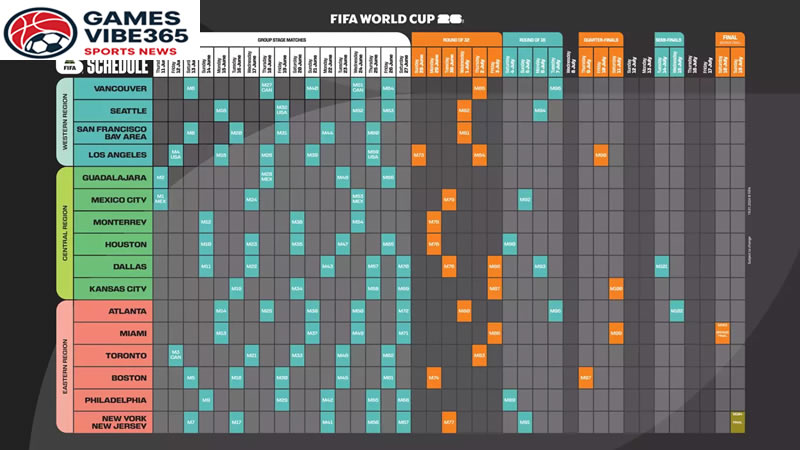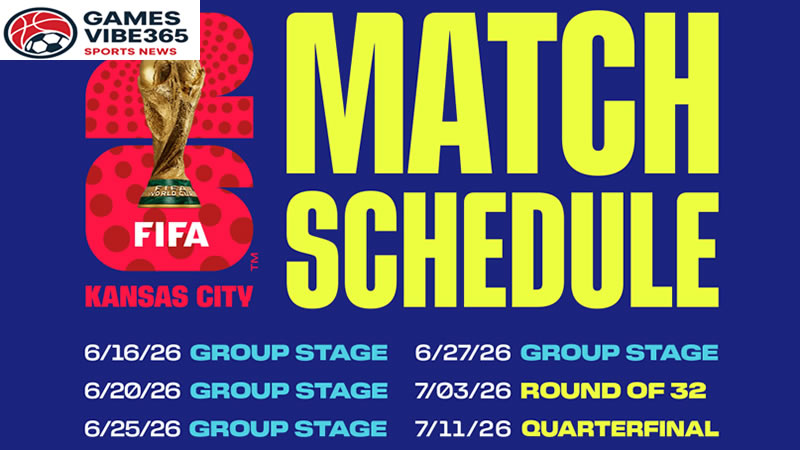The FIFA World Cup 2026 match schedule is the official timeline and structure for the world’s largest and most prestigious international football tournament, detailing when and where each game will be played, from the opening kickoff to the final whistle.
This edition of the World Cup is unprecedented. It spans 39 days, features a record 48 national teams, and will be contested across three host nations Canada, Mexico, and the United States using 16 stadiums in 16 cities. This is a historic leap from the 32-team, single or dual-host format fans have been familiar with since 1998.
Expert Insight: Former FIFA Secretary General Jerome Valcke once noted, A tournament’s schedule is not just a calendar it’s the heartbeat of the competition.” This heartbeat in 2026 will be faster, louder, and more globally inclusive than ever before.

In this comprehensive guide, we will break down the entire schedule, tournament structure, venue allocation, and key dates, while explaining why this schedule matters to fans, teams, and the sport’s future.
Tournament Overview
The FIFA World Cup 2026 will run from June 11 to July 19, 2026.
This extended timeline accommodates the expanded match count 104 games instead of the previous 64.
Key Milestones:
- Opening Match: June 11, 2026 – Estadio Azteca, Mexico City.
- Group Stage: June 11 to June 27.
- Knockout Rounds: June 29 to July 19.
- Final: July 19, 2026 – MetLife Stadium, New Jersey.
Why the Expansion?
FIFA’s aim is to broaden participation allowing more nations to qualify and giving fans from emerging football regions a chance to see their teams on the world stage. Statistically, this means representation from all six continental confederations will reach record highs.
Format Changes in FIFA 2026
The Group Stage
- Definition: A round-robin phase where teams compete in mini-leagues before advancing to the knockout stage.
- Structure: 12 groups of 4 teams (Groups A–L).
- Advancement: The top two teams in each group, plus the eight best third-placed teams, move forward to the Round of 32.
- Rationale: This keeps the fairness of the traditional 3-match group phase while accommodating more teams.
The Knockout Stage
- New Feature: The Round of 32 replaces the previous immediate jump to the Round of 16.
- Progression Path:
Round of 32 → Round of 16 → Quarter-finals → Semi-finals → Final.
Efficiency Tip for Fans: Since matches in the knockout stages are single elimination, fans planning travel should secure tickets for both the game they attend and the potential next round in nearby cities to avoid last-minute scarcity.
Host Nations and Venues
Geographic Spread
This will be the first World Cup with three host countries, creating a truly continental championship.
United States – 11 Cities
- Atlanta, Boston, Dallas, Houston, Kansas City, Los Angeles, Miami, New York/New Jersey, Philadelphia, San Francisco Bay Area, Seattle.
Canada – 2 Cities
- Toronto, Vancouver.
Mexico – 3 Cities
- Mexico City, Guadalajara, Monterrey.
Purpose: This distribution ensures equitable economic benefits, reduces overuse of a single venue, and maximizes the opportunity for local fans to experience World Cup matches.
Group Stage Schedule Breakdown
The group stage is spread strategically to minimize long-haul travel for teams and supporters.
Example Schedule Flow:
- Day 1 (June 11): Opening ceremony + Mexico’s opening match in Mexico City.
- Day 2 (June 12): Matches in Toronto, Los Angeles.
- Day 3 (June 13): Matches in Boston, Vancouver.
- Pattern: Multiple games per day, staggered by time zones to optimize global television viewership.

Measurement of Quality: The success of this scheduling method can be gauged by average attendance rates, travel efficiency scores, and broadcast ratings.
Knockout Phase Explained
Definition: A stage where only the winners progress, and losers are eliminated.
Efficiency Note: Unlike previous editions, the Round of 32 means knockout matches will start earlier resulting in more high-stakes football sooner.
Sample Flow:
- Round of 32: June 29–July 2.
- Round of 16: July 4–July 7.
- Quarter-finals: July 9–July 11.
- Semi-finals: July 14–July 15.
- Final: July 19.
Why the 2026 Schedule Is a Game-Changer
Efficiency:
- Reduces downtime between matches for fans.
- Balances host city usage to prevent logistical overload.
Quality:
- Increased competitive diversity.
- More opportunities for underdog stories.
Purpose:
- Grow football’s global footprint.
- Give emerging nations a bigger platform.
Expert Comment: Sports economist Dr. Stefan Szymanski observes, “Expanding the schedule is as much an investment in the sport’s future as it is in the present spectacle.”
How to Navigate the Schedule as a Fan
- Use Official Mobile Apps: FIFA’s app will allow you to filter matches by city, team, or date.
- Plan Regionally: Pick a cluster of host cities and follow matches within that zone.
- Book Early: Accommodation in host cities will be scarce secure stays 12–18 months in advance.
Conclusion
The FIFA World Cup 2026 match schedule is more than a list of fixtures. It is a carefully engineered plan designed to balance competitiveness, logistics, and entertainment value.
From the opening spectacle in Mexico City to the grand finale in New Jersey, this schedule promises a month-long festival of football unlike any other in history.
